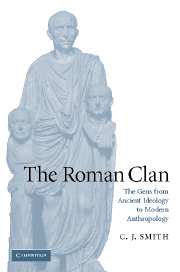Book contents
- Frontmatter
- Contents
- List of illustrations
- Preface
- List of abbreviations
- General introduction
- Part I THE EVIDENCE FOR THE GENS
- Chapter 1 The ancient evidence
- Chapter 2 Modern interpretations
- Chapter 3 The gens in the mirror: Roman gens and Attic genos
- Chapter 4 Archaeology and the gens
- Part I: Conclusion
- Part II TOWARDS AN INTERPRETATION OF THE GENS
- Appendix 1 Dionysius of Halicarnassus on the Roman curiae and religion
- Appendix 2 The missing curiae
- Select bibliography
- General index
- Index of ancient persons
- Index of passages discussed
Chapter 4 - Archaeology and the gens
Published online by Cambridge University Press: 22 September 2009
- Frontmatter
- Contents
- List of illustrations
- Preface
- List of abbreviations
- General introduction
- Part I THE EVIDENCE FOR THE GENS
- Chapter 1 The ancient evidence
- Chapter 2 Modern interpretations
- Chapter 3 The gens in the mirror: Roman gens and Attic genos
- Chapter 4 Archaeology and the gens
- Part I: Conclusion
- Part II TOWARDS AN INTERPRETATION OF THE GENS
- Appendix 1 Dionysius of Halicarnassus on the Roman curiae and religion
- Appendix 2 The missing curiae
- Select bibliography
- General index
- Index of ancient persons
- Index of passages discussed
Summary
INTRODUCTION
My intention in this chapter is to explore the archaeological evidence for gens-like structures in Latium, focussing on the two sites of Osteria dell'Osa and Satricum, and considering in brief the contribution which the Auditorio villa site has made to our understanding of early agriculture and land use in Latium. Having established that there is a division to be drawn between the social anthropological concept of gentilicial society, and the ancient historical reality, I wish to investigate two sites where the two have been brought together. In fact the concept of gentilicial society is widespread, particularly in Italian scholarship, and my approach has wider consequences. Nevertheless, there is perhaps a difference between a generalised reference to gentilicial society and a specific definition of an archaeologically identified group as a gens, and it is this which most concerns us here. It is important to be clear from the outset that in the two case-studies considered here, the possibility for the degree of specificity in the argument is entirely due on the one hand to the outstanding quality of the excavation, and on the other to the superb reconstruction of a much less well-excavated site. My disagreements with the conclusions take nothing from my admiration of the work that has been conducted.
- Type
- Chapter
- Information
- The Roman ClanThe Gens from Ancient Ideology to Modern Anthropology, pp. 144 - 163Publisher: Cambridge University PressPrint publication year: 2006

